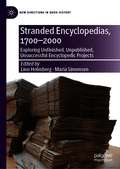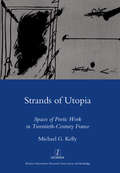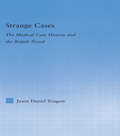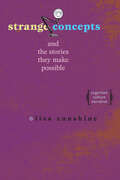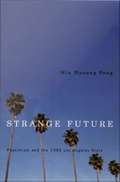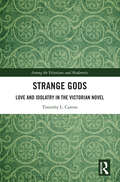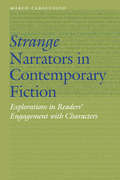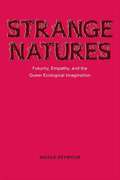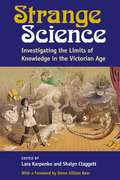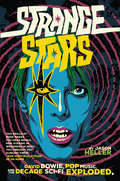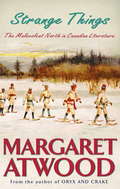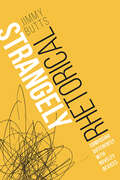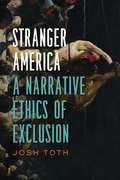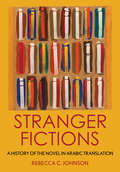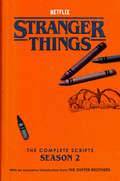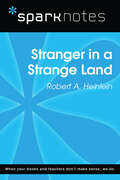- Table View
- List View
Stranded Encyclopedias, 1700–2000: Exploring Unfinished, Unpublished, Unsuccessful Encyclopedic Projects (New Directions in Book History)
by Linn Holmberg Maria SimonsenIn Stranded Encyclopedias, 1700–2000: Exploring Unfinished, Unpublished, Unsuccessful Encyclopedic Projects, fourteen scholars turn to the archives to challenge the way the history of modern encyclopedism has long been told. Rather than emphasizing successful publications and famous compilers, they explore encyclopedic enterprises that somehow failed. With a combined attention to script, print, and digital cultures, the volume highlights the many challenges facing those who have pursued complete knowledge in the past three hundred years. By introducing the concepts of stranded and strandedness, it also provides an analytical framework for approaching aspects often overlooked in histories of encyclopedias, books, and learning: the unpublished, the unfinished, the incomplete, the unsuccessfully disseminated, and the no-longer-updated. By examining these aspects in a new and original way, this book will be of value to anyone interested in the history of encyclopedism and lexicography, the history of knowledge, language, and ideas, and the history of books, writing, translating, and publishing. Chapters 1 and 4 are available open access under a Creative Commons Attribution 4.0 International License via link.springer.com.
Strands of Utopia: Spaces of Poetic Work in Twentieth Century France
by Michael G Kelly"The poetic is an abiding yet elusive qualification within the discursive system of twentieth-century French literature. No longer amenable to formal assignment, its recurrences delimit a shifting, multi-layered practice of artistic and intellectual (self-) invention. This study attempts to outline certain durable properties of that practice by confronting it with the complex theoretical and spatial metaphor of utopia. Drawing, in particular, upon the oeuvres of Victor Segalen (1878-1919), Rene Daumal (1908-44) and Yves Bonnefoy (b. 1923), it traces poetic work - work done in support of poetic difference - along the social, physical and textual axes of what is argued to be a sustained and radically inclusive utopian practice within the literary field. The complex utopian quality of poetic work is linked to the cultural persistence of the poetic as a simple attribute within literary practice. In uncovering this link, the study encourages revised understandings of both the poetic and the utopian in the modern French literary context."
Strange Cases: The Medical Case History and the British Novel (Literary Criticism and Cultural Theory)
by Jason TougawStrange Cases is the story of the mutual influence of the case history and the British novel during the eighteenth and nineteenth centuries. Fictions from Defoe's Roxana to James's The Turn of the Screw and case histories from George Cheyne's to Sigmund Freud's have found narrative impetus in pathology. The writer of a case history faces a rhetorical bind unique to the human sciences: the need to display the acumen of a scientist and the sympathy warranted to the suffering patient. Repeatedly, case historians justify their publicizing of extreme, often morbid or perverse, states of mind and body by appealing to readers to take pity on patients and to recognize the narrative as a vital social document. Diagnosis and sympathy, explicit rhetorical modes in case histories, operate implicitly in novels, shaping reader-identification. While these two narrative forms set out to fulfill an Enlightenment drive to classify and explain, they also raise social and epistemological questions that challenge some of the Enlightenment's most cherished ideals, including faith in reason, the perfectibility of humankind, and the stability of truth.
Strange Cocktail: Translation and the Making of Modern Hebrew Poetry (Michigan Studies In Comparative Jewish Cultures)
by Adriana X. JacobsFor centuries, poets have turned to translation for creative inspiration. Through and in translation, poets have introduced new poetic styles, languages, and forms into their own writing, sometimes changing the course of literary history in the process. Strange Cocktail is the first comprehensive study of this phenomenon in modern Hebrew literature of the late nineteenth century to the present day. Its chapters on Esther Raab, Leah Goldberg, Avot Yeshurun, and Harold Schimmel offer close readings that examine the distinct poetics of translation that emerge from reciprocal practices of writing and translating. Working in a minor literary vernacular, the translation strategies that these poets employed allowed them to create and participate in transnational and multilingual poetic networks. Strange Cocktail thereby advances a comparative and multilingual reframing of modern Hebrew literature that considers how canons change and are undone when translation occupies a central position—how lines of influence and affiliation are redrawn and literary historiographies are revised when the work of translation occupies the same status as an original text, when translating and writing go hand in hand.
Strange Concepts and the Stories They Make Possible: Cognition, Culture, Narrative
by Lisa ZunshineIn this fresh and often playful interdisciplinary study, Lisa Zunshine presents a fluid discussion of how key concepts from cognitive science complicate our cultural interpretations of "strange" literary phenomena.From Short Circuit to I, Robot, from The Parent Trap to Big Business, fantastic tales of rebellious robots, animated artifacts, and twins mistaken for each other are a permanent fixture in popular culture and have been since antiquity. Why do these strange concepts captivate the human imagination so thoroughly? Zunshine explores how cognitive science, specifically its ideas of essentialism and functionalism, combined with historical and cultural analysis, can help us understand why we find such literary phenomena so fascinating.Drawing from research by such cognitive evolutionary anthropologists and psychologists as Scott Atran, Paul Bloom, Pascal Boyer, and Susan A. Gelman, Zunshine examines the cognitive origins of the distinction between essence and function and how unexpected tensions between these two concepts are brought into play in fictional narratives. Discussing motifs of confused identity and of twins in drama, science fiction’s use of robots, cyborgs, and androids, and nonsense poetry and surrealist art, she reveals the range and power of key concepts from science in literary interpretation and provides insight into how cognitive-evolutionary research on essentialism can be used to study fiction as well as everyday strange concepts.
Strange Footing: Poetic Form and Dance in the Late Middle Ages
by Seeta ChagantiFor premodern audiences, poetic form did not exist solely as meter, stanzas, or rhyme scheme. Rather, the form of a poem emerged as an experience, one generated when an audience immersed in a culture of dance encountered a poetic text. Exploring the complex relationship between medieval dance and medieval poetry, Strange Footing argues that the intersection of texts and dance produced an experience of poetic form based in disorientation, asymmetry, and even misstep. Medieval dance guided audiences to approach poetry not in terms of the body’s regular marking of time and space, but rather in the irregular and surprising forces of virtual motion around, ahead of, and behind the dancing body. Reading medieval poems through artworks, paintings, and sculptures depicting dance, Seeta Chaganti illuminates texts that have long eluded our full understanding, inviting us to inhabit their strange footings askew of conventional space and time.Strange Footing deploys the motion of dance to change how we read medieval poetry, generating a new theory of poetic form for medieval studies and beyond.
Strange Future: Pessimism and the 1992 Los Angeles Riots
by Min Hyoung SongSometime near the start of the 1990s, the future became a place of national decline. The United States had entered a period of great anxiety fueled by the shrinking of the white middle class, the increasingly visible misery of poor urban blacks, and the mass immigration of nonwhites. Perhaps more than any other event marking the passage through these dark years, the 1992 Los Angeles riots have sparked imaginative and critical works reacting to this profound pessimism. Focusing on a wide range of these creative works, Min Hyoung Song shows how the L. A. riots have become a cultural-literary event--an important reference and resource for imagining the social problems plaguing the United States and its possible futures. Song considers works that address the riots and often the traumatic place of the Korean American community within them: the independent documentary Sa-I-Gu (Korean for April 29, the date the riots began), Chang-rae Lee's novel Native Speaker, the commercial film Strange Days, and the experimental drama of Anna Deavere Smith, among many others. He describes how cultural producers have used the riots to examine the narrative of national decline, manipulating language and visual elements, borrowing and refashioning familiar tropes, and, perhaps most significantly, repeatedly turning to metaphors of bodily suffering to convey a sense of an unraveling social fabric. Song argues that these aesthetic experiments offer ways of revisiting the traumas of the past in order to imagine more survivable futures.
Strange Gods: Love and Idolatry in the Victorian Novel (Among the Victorians and Modernists)
by Timothy L. CarensDespite frequent declarations of the sanctity of love and marriage, British Protestant culture nurtured the fear that human affection might easily slip into idolatry. Throughout the nineteenth-century, theological essays, sermons, hymns, and didactic fiction and poetry urged the faithful to maintain a constant watch over their hearts, lest they become engrossed by human love, guilty of worshipping the creature rather than the Creator. Strange Gods: Love and Idolatry in the Victorian Novel traces the concerns produced in Protestant culture by this broad interpretation of idolatry. In chapters focusing on Charles Kingsley and Charlotte Brontë, Mary Elizabeth Braddon, George Eliot, Oscar Wilde, and Thomas Hardy, this volume shows that even supposedly secular novels obsessively reenact an ideological clash between Protestant faith and human love. Anxiety about adoring humans more than God frequently overshadows and sometimes derails the progress of romance in Victorian novels. By probing this anxiety and its narrative effects, Strange Gods uncovers how a central Protestant belief exerts its influence over stories about love and marriage.
Strange Gourmets: Sophistication, Theory, and the Novel
by Joseph LitvakTheoretically sophisticated: How often has this term been used to distinguish a work of contemporary criticism, and what, exactly, does it mean? In Strange Gourmets, Joseph Litvak reclaims sophistication from its negative connotations and turns the spotlight on those who, even as they demonize sophistication, surreptitiously and extensively use it.Though commonly thought of as a kind of worldliness at its best and an elitist snobbery at its worst, sophistication, Litvak reminds us, remains tied to its earlier, if forgotten, meaning of "perversion"--a perversion whose avatars are the homosexual and the intellectual. Proceeding with his investigations from a specifically gay academic perspective, Litvak presents thoroughly inventive readings of novels by Austen, Thackeray, and Proust, and of theoretical works by Adorno and Barthes, each text epitomizing sophistication in one of its more familiar modes. Among the issues he explores are the ways in which these texts teach sophistication, the embarrassment that sophistication causes the sophisticated, and how the class politics of sophistication are inseparable from its sexual politics. Helping gay, queer, feminist, and other provocative critics to make the most of their bad publicity, Litvak mindfully celebrates sophistication's economy of taste and pleasure.
Strange Likeness: Description and the Modernist Novel (Thinking Literature)
by Dora ZhangThe modern novel, so the story goes, thinks poorly of mere description—what Virginia Woolf called “that ugly, that clumsy, that incongruous tool.” As a result, critics have largely neglected description as a feature of novelistic innovation during the twentieth century. Dora Zhang argues that descriptive practices were in fact a crucial site of attention and experimentation for a number of early modernist writers, centrally Woolf, Henry James, and Marcel Proust. Description is the novelistic technique charged with establishing a common world, but in the early twentieth century, there was little agreement about how a common world could be known and represented. Zhang argues that the protagonists in her study responded by shifting description away from visualizing objects to revealing relations—social, formal, and experiential—between disparate phenomena. In addition to shedding new light on some of the best-known works of modernism, Zhang opens up new ways of thinking about description more broadly. She moves us beyond the classic binary of narrate-or-describe and reinvigorates our thinking about the novel. Strange Likeness will enliven conversations around narrative theory, affect theory, philosophy and literature, and reading practices in the academy.
Strange Narrators in Contemporary Fiction: Explorations in Readers' Engagement with Characters (Frontiers of Narrative)
by Marco CaraccioloA storyteller’s craft can often be judged by how convincingly the narrative captures the identity and personality of its characters. In this book, the characters who take center stage are “strange” first-person narrators: they are fascinating because of how they are at odds with what the reader would wish or expect to hear—while remaining reassuringly familiar in voice, interactions, and conversations. Combining literary analysis with research in cognitive and social psychology, Marco Caracciolo focuses on readers’ encounters with the “strange” narrators of ten contemporary novels, including Bret Easton Ellis’s American Psycho, Haruki Murakami’s Hard-Boiled Wonderland and the End of the World, and Mark Haddon’s The Curious Incident of the Dog in the Night-Time. Caracciolo explores readers’ responses to narrators who suffer from neurocognitive or developmental disorders, who are mentally disturbed due to multiple personality disorder or psychopathy, whose consciousness is split between two parallel dimensions or is disembodied, who are animals, or who lose their sanity. A foray into current work on reception, reader-response, cognitive literary study, and narratology, Strange Narrators in Contemporary Fiction illustrates why any encounter with a fictional text is a complex negotiation of interlaced feelings, thoughts, experiences, and interpretations.
Strange Natures: Futurity, Empathy, and the Queer Ecological Imagination
by Nicole SeymourIn Strange Natures, Nicole Seymour investigates the ways in which contemporary queer fictions offer insight on environmental issues through their performance of a specifically queer understanding of nature, the nonhuman, and environmental degradation. By drawing upon queer theory and ecocriticism, Seymour examines how contemporary queer fictions extend their critique of "natural" categories of gender and sexuality to the nonhuman natural world, thus constructing a queer environmentalism. Seymour's thoughtful analyses of works such as Leslie Feinberg's Stone Butch Blues, Todd Haynes's Safe, and Ang Lee's Brokeback Mountain illustrate how homophobia, classism, racism, sexism, and xenophobia inform dominant views of the environment and help to justify its exploitation. Calling for a queer environmental ethics, she delineates the discourses that have worked to prevent such an ethics and argues for a concept of queerness that is attuned to environmentalism's urgent futurity, and an environmentalism that is attuned to queer sensibilities.
Strange Science: Investigating the Limits of Knowledge in the Victorian Age
by Lara Pauline Karpenko Shalyn Rae ClaggettThe essays in Strange Science examine marginal, fringe, and unconventional forms of scientific inquiry, as well as their cultural representations, in the Victorian period. Although now relegated to the category of the pseudoscientific, fields like mesmerism and psychical research captured the imagination of the Victorian public. Conversely, many branches of science now viewed as uncontroversial, such as physics and botany, were often associated with unorthodox methods of inquiry. Whether ultimately incorporated into mainstream scientific thought or categorized by 21st century historians as pseudo- or even anti-scientific, these sciences generated conversation, enthusiasm, and controversy within Victorian society. To date, scholarship addressing Victorian pseudoscience tends to focus either on a particular popular science within its social context or on how mainstream scientific practice distinguished itself from more contested forms. Strange Science takes a different approach by placing a range of sciences in conversation with one another and examining the similar unconventional methods of inquiry adopted by both now-established scientific fields and their marginalized counterparts during the Victorian period. In doing so, Strange Science reveals the degree to which scientific discourse of this period was radically speculative, frequently attempting to challenge or extend the apparent boundaries of the natural world. This interdisciplinary collection will appeal to scholars in the fields of Victorian literature, cultural studies, the history of the body, and the history of science.
Strange Stars: How Science Fiction and Fantasy Transformed Popular Music
by Jason HellerA Hugo Award-winning author and music journalist explores the weird and wild story of when rock ’n’ roll met the sci-fi world of the 1970sAs the 1960s drew to a close, and mankind trained its telescopes on other worlds, old conventions gave way to a new kind of hedonistic freedom that celebrated sex, drugs, and rock ’n’ roll. Derided as nerdy or dismissed as fluff, science fiction rarely gets credit for its catalyzing effect on this revolution.In Strange Stars, Jason Heller recasts sci-fi and pop music as parallel cultural forces that depended on one another to expand the horizons of books, music, and out-of-this-world imagery.In doing so, he presents a whole generation of revered musicians as the sci-fi-obsessed conjurers they really were: from Sun Ra lecturing on the black man in the cosmos, to Pink Floyd jamming live over the broadcast of the Apollo 11 moon landing; from a wave of Star Wars disco chart toppers and synthesiser-wielding post-punks, to Jimi Hendrix distilling the “purplish haze” he discovered in a pulp novel into psychedelic song. Of course, the whole scene was led by David Bowie, who hid in the balcony of a movie theater to watch 2001: A Space Odyssey, and came out a changed man…If today’s culture of Comic Con fanatics, superhero blockbusters, and classic sci-fi reboots has us thinking that the nerds have won at last, Strange Stars brings to life an era of unparalleled and unearthly creativity—in magazines, novels, films, records, and concerts—to point out that the nerds have been winning all along.
Strange Things: The Malevolent North in Canadian Literature
by Margaret AtwoodMargaret Atwood's witty and informative book focuses on the imaginative mystique of the wilderness of the Canadian North. She discusses the 'Grey Owl Syndrome' of white writers going native; the folklore arising from the mysterious-- and disastrous -- Franklin expedition of the nineteenth century; the myth of the dreaded snow monster, the Wendigo; the relations between nature writing and new forms of Gothic; and how a fresh generation of women writers in Canada have adapted the imagery of the Canadian North for the exploration of contemporary themes of gender, the family and sexuality. Writers discussed include Robert Service, Robertson Davies, Alice Munro, E.J. Pratt, Marian Engel, Margaret Laurence, and Gwendolyn MacEwan.This superbly written and compelling portrait of the mysterious North is at once a fascinating insight into the Canadian imagination, and an exciting new work from an outstanding literary presence.
Strange Truths in Undiscovered Lands
by Nahoko Miyamoto AlveyThe great Romantic poet Percy Bysshe Shelley had a complicated relationship with the British Empire and the culture of colonialism. Considered politically radical and scandalous in Britain, Shelley lived in self-imposed exile and set much of his writing in foreign places. In Strange Truths in Undiscovered Lands Nahoko Miyamoto Alvey examines the ways in which Shelley developed a 'Romantic geography' to provide visionary alternatives to an earth devastated by a new type of European colonialism and global expansion. Intertextually rich, Alvey's work establishes the context in which poems by Shelley and other Romantics were written by presenting relevant histories, travel texts, scientific writings, and archival material, and are all complemented by postcolonial analysis. Unique in its emphasis on the optimistic and positive aspects of Shelley's poetical works, Strange Truths in Undiscovered Lands offers a different perspective on Romantic Orientalism, and a new look at how the poet imagined the relationship between the Self and the Other. Thorough and original, this book will be of interest to Romanticists, postcolonialists, and anyone interested in alternative responses to acts of colonialism and empire.
Strange Vernaculars: How Eighteenth-Century Slang, Cant, Provincial Languages, and Nautical Jargon Became English
by Janet SorensenHow vocabularies once associated with outsiders became objects of fascination in eighteenth-century BritainWhile eighteenth-century efforts to standardize the English language have long been studied—from Samuel Johnson's Dictionary to grammar and elocution books of the period—less well-known are the era's popular collections of odd slang, criminal argots, provincial dialects, and nautical jargon. Strange Vernaculars delves into how these published works presented the supposed lexicons of the "common people" and traces the ways that these languages, once shunned and associated with outsiders, became objects of fascination in printed glossaries—from The New Canting Dictionary to Francis Grose's Classical Dictionary of the Vulgar Tongue—and in novels, poems, and songs, including works by Daniel Defoe, John Gay, Samuel Richardson, Robert Burns, and others.Janet Sorensen argues that the recognition and recovery of outsider languages was part of a transition in the eighteenth century from an aristocratic, exclusive body politic to a British national community based on the rhetoric of inclusion and liberty, as well as the revaluing of a common British past. These representations of the vernacular made room for the "common people" within national culture, but only after representing their language as "strange." Such strange and estranged languages, even or especially in their obscurity, came to be claimed as British, making for complex imaginings of the nation and those who composed it. Odd cant languages, witty slang phrases, provincial terms newly valued for their connection to British history, or nautical jargon repurposed for sentimental connections all toggle, in eighteenth-century jest books, novels, and poems, between the alluringly alien and familiarly British.Shedding new light on the history of the English language, Strange Vernaculars explores how eighteenth-century British literature transformed the patois attributed to those on the margins into living symbols of the nation.Examples of slang from Strange Vernaculars bum-boat woman: one who sells bread, cheese, greens, and liquor to sailors from a small boat alongside a ship collar day: execution day crewnting: groaning, like a grunting horse gentleman's companion: lice gingerbread-work: gilded carvings of a ship's bow and stern luggs: ears mort: a large amount thraw: to argue hotly and loudly
Strangely Rhetorical: Composing Differently With Novelty Devices
by Jimmy ButtsStrangely Rhetorical establishes the groundwork for strangeness as a lens under the broader interdisciplinary umbrella of rhetoric and composition and shares a series of rhetorical devices for practically thinking about how compositions are made unique. Jimmy Butts explores how strange, novel, weird, and interesting texts work and offers insight into how and why these forms can be invented, created, and stylized to generate the effective delivery of rhetorical messages in fun, divergent ways. Using a new theoretical framework—that strangeness is inherent within all rhetorical interactions and is potentially useful—Butts demonstrates how rhetoric is always already coming from an Other, offering an ethical context for how defamiliarized texts work with different audiences. Applying examples of seven figures for composing in and across written, aural, visual, electronic, and spatial texts (the WAVES of media), Butts shows how divergence is possible in all sorts of refigured multimodal ways. Strangely Rhetorical rethinks what exactly rhetoric is and does, considering the ways that strange compositions help rhetors connect across a broad range of networks in a world haunted by distance. This is a book about strange rhetoric for makers and creatives, for students and teachers, and for composers of all sorts.
Stranger America: A Narrative Ethics of Exclusion (Cultural Frames, Framing Culture)
by Josh TothContradictory ideals of egalitarianism and self-reliance haunt America’s democratic state. We need look no further than Donald Trump’s 2016 presidential campaign and victory for proof that early twentieth-century anxieties about individualism, race, and the foreign or intrusive "other" persist today. In Stranger America, Josh Toth tracks and delineates these anxieties in America’s aesthetic production, finally locating a potential narrative strategy for circumnavigating them.Toth’s central focus is, simply, strangeness—or those characters who adamantly resist being fixed in any given category of identity. As with the theorists employed (Nancy, i ek, Derrida, Freud, Hegel), the subjects and literature considered are as encompassing as possible: from the work of Herman Melville, William Faulkner, James Weldon Johnson, and Nella Larsen to that of Philip K. Dick, Woody Allen, Larry David, and Bob Dylan; from the rise of nativism in the early twentieth century to object-oriented ontology and the twenty-first-century zombie craze; from ragtime and the introduction of sound in American cinema to the exhaustion of postmodern metafiction.Toth argues that American literature, music, film, and television can show us the path toward a new ethic, one in which we organize identity around the stranger rather than resorting to tactics of pure exclusion or inclusion. Ultimately, he provides a new narrative approach to otherness that seeks to realize a truly democratic form of community.
Stranger Fictions: A History of the Novel in Arabic Translation
by Rebecca C. JohnsonZaynab, first published in 1913, is widely cited as the first Arabic novel, yet the previous eight decades saw hundreds of novels translated into Arabic from English and French. This vast literary corpus influenced generations of Arab writers but has, until now, been considered a curious footnote in the genre's history. Incorporating these works into the history of the Arabic novel, Stranger Fictions offers a transformative new account of modern Arabic literature, world literature, and the novel.Rebecca C. Johnson rewrites the history of the global circulation of the novel by moving Arabic literature from the margins of comparative literature to its center. Considering the wide range of nineteenth- and early twentieth-century translation practices—including "bad" translation, mistranslation, and pseudotranslation—Johnson argues that Arabic translators did far more than copy European works; they authored new versions of them, producing sophisticated theorizations of the genre. These translations and the reading practices they precipitated form the conceptual and practical foundations of Arab literary modernity, necessitating an overhaul of our notions of translation, cultural exchange, and the global.Examining nearly a century of translations published in Beirut, Cairo, Malta, Paris, London, and New York, from Qiat Rūbinun Kurūzī (The story of Robinson Crusoe) in 1835 to pastiched crime stories in early twentieth-century Egyptian magazines, Johnson shows how translators theorized the Arab world not as Europe's periphery but as an alternative center in a globalized network. Stranger Fictions affirms the central place of (mis)translation in both the history of the novel in Arabic and the novel as a transnational form itself.
Stranger Magic: Charmed States and the Arabian Nights
by Marina WarnerOur foremost theorist of myth, fairytales, and folktales explores the magical realm of the imagination where carpets fly, objects speak, dreams reveal hidden truths, and genies grant prophetic wishes. Stranger Magic examines the wondrous tales of the Arabian Nights, their profound impact on the West, and the progressive exoticization of magic since the eighteenth century, when the first European translations appeared. The Nights seized European readers’ imaginations during the siècle des Lumières, inspiring imitations, spoofs, turqueries, extravaganzas, pantomimes, and mauresque tastes in dress and furniture. Writers from Voltaire to Goethe to Borges, filmmakers from Raoul Walsh on, and countless authors of children’s books have adapted its stories. What gives these tales their enduring power to bring pleasure to readers and audiences? Their appeal, Marina Warner suggests, lies in how the stories’ magic stimulates the creative activity of the imagination. Their popularity during the Enlightenment was no accident: dreams, projections, and fantasies are essential to making the leap beyond the frontiers of accepted knowledge into new scientific and literary spheres. The magical tradition, so long disavowed by Western rationality, underlies modernity’s most characteristic developments, including the charmed states of brand-name luxury goods, paper money, and psychoanalytic dream interpretation. In Warner’s hands, the Nights reveal the underappreciated cultural exchanges between East and West, Islam and Christianity, and cast light on the magical underpinnings of contemporary experience, where mythical principles, as distinct from religious belief, enjoy growing acceptance. These tales meet the need for enchantment, in the safe guise of oriental costume.
Stranger Things: Hawkins ABCs (Little Golden Book)
by Geof SmithLearn the alphabet with adorable Funko Pop! versions of your favorite characters from Netflix&’s Stranger Things in this Little Golden Book.Follow the alphabet from A to Z with humorous scenes around Hawkins that introduce charming Funko Pop! versions of Eleven, Dustin, Lucas, Erica, and other popular characters in this offbeat book. Funko collectors of all ages and fans of Netflix&’s hit series Stranger Things will love this new addition to the Little Golden Book line.Welcome to the thrilling world of Netflix's hit series Stranger Things. Follow Eleven, Dustin, Max, Lucas, and their friends for mystery, suspense, and supernatural adventures in 1980s Hawkins.Little Golden Books enjoy nearly 100% consumer recognition. They feature beloved classics, hot licenses, and new original stories . . . the classics of tomorrow.Look for this other great Stranger Things Little Golden Book!We Can Count on ElevenInside, Outside, Upside Down
Stranger Things: The Complete Scripts, Season 1 (Stranger Things)
by Netflix The Duffer BrothersGo deeper into the groundbreaking Emmy-winning series with the complete, authorized scripts of Stranger Things: Season One, including an exclusive introduction from the Duffer Brothers.A high-pitched shrieking sound suddenly fills the shed. We don&’t see what happens to Will; we just watch that naked dangling light bulb. It glows brighter and brighter and brighter, filling the shed with overwhelming white light. We think the glass of the bulb is going to shatter but then — The terrible shrieking sound abruptly stops.The bulb dims. Returning to normal wattage.We pull away from the light.The shed is empty.Will has vanished.When young Will Byers disappears, the sleepy little town of Hawkins, Indiana, is awakened to a mystery involving secret experiments, terrifying supernatural forces, and a strange little girl with a tattoo of the number eleven on her arm . . . and the ability to move objects with her mind.The Duffer Brothers&’ critically acclaimed series, Stranger Things, took the world by storm with its 80s nostalgia, dimension-hopping secrets, and charming cast of characters. Season One introduced us to our favorite friend squad—Mike, Dustin, Lucas, and Will—plus their new Eggo-loving friend, El, and to the terrifying &“Upside Down,&” an evil alternate dimension with a species of humanoid predators roaming the landscape. Collected here for the first time, the complete scripts of Stranger Things: Season One include the scenes, dialogue, and character directions for all eight episodes as well as an exclusive introduction from the creators and showrunners, Matt and Ross Duffer. Season One&’s scripts reveal a unique insight into the foundational story that immediately captivated viewers and popular culture.
Stranger Things: The Complete Scripts, Season 2 (Stranger Things)
by Netflix The Duffer BrothersGo deeper into the groundbreaking Emmy-winning series with the complete, authorized scripts of Stranger Things: Season Two, including an exclusive introduction from the Duffer Brothers.EXT. DOWNTOWN HAWKINS - THE PALACE (THE UPSIDE DOWN)Will steps outside. Scared. Cautious.It&’s a very familiar nightmare landscape. Fog. Spores. Nether growths. Only. . . it&’s worse now. The spores are heavier; the growths, thicker, smothering the buildings. If the Upside Down is a supernatural cancer . . . then that cancer has spread.Nearly a year after the Demogorgon attacked Hawkins and Eleven sacrificed herself to save her friends, life has largely returned to normal for everyone. Mike and his friends are competing for high scores at the new arcade. Hopper is dealing with locals complaining about rotting crops. And Joyce is dating super nice guy, Bob. But Will is still being plagued with terrifying visions of the Upside Down, and the rot affecting local crops is spreading . . . and stemming from Hawkins Lab.The Duffer Brothers&’ critically acclaimed series, Stranger Things, took the world by storm with its 80s nostalgia, dimension-hopping secrets, and charming cast of characters. Season Two brings a cool new kid Max and her jerk brother, Billy, to Hawkins along with TV dinners for El and Hopper; Bob&’s heroics; the cute-but-suddenly-not-cute demodogs; and the terrifying Mind Flayer.Collected here for the first time, the complete scripts of Stranger Things: Season Two include the scenes, dialogue, and character directions for all nine episodes as well as an exclusive introduction from the creators and showrunners, Matt and Ross Duffer.
Stranger in a Strange Land (SparkNotes Literature Guide Series)
by SparkNotesStranger in a Strange Land (SparkNotes Literature Guide) by Robert A. Heinlein Making the reading experience fun! Created by Harvard students for students everywhere, SparkNotes is a new breed of study guide: smarter, better, faster. Geared to what today's students need to know, SparkNotes provide: *Chapter-by-chapter analysis *Explanations of key themes, motifs, and symbols*A review quiz and essay topicsLively and accessible, these guides are perfect for late-night studying and writing papers.
